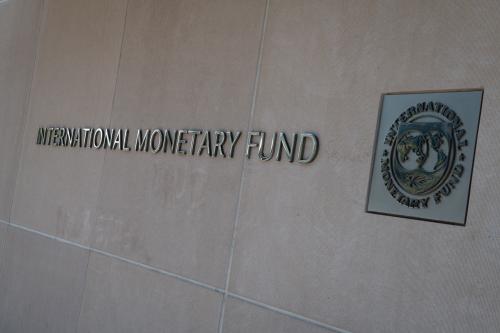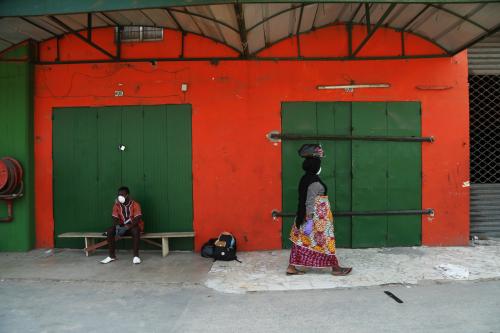The International Monetary Fund (IMF) just published its World Economic Outlook for 2020 and 2021. To nobody’s surprise, it says that “the global economy is projected to contract sharply by –3 percent in 2020, much worse than during the 2008–09 financial crisis.” The U.S. economy is projected to shrink this year by 5.9 percent and the euro area by 7.5 percent; China will grow at a measly 1.2 percent.
Before you rush to restructure your retirement portfolio, read what the IMF said on April 2009. Keep in mind that the world economy was in full freefall back then, not in the middle of a deliberate downturn.
“Even with determined steps to return the financial sector to health and continued use of macroeconomic policy levers to support aggregate demand, global activity is projected to contract by 1.3 percent in 2009. … Moreover, the downturn is truly global: output per capita is projected to decline in countries representing three-quarters of the global economy. Growth is projected to reemerge in 2010, but at 1.9 percent it would be sluggish relative to past recoveries.”
What actually happened over the next two years? Global GDP did contract in 2009 but by 0.7 percent, half the rate predicted by the IMF. In 2010, it grew by a whopping 5.1 percent (Table 1).
Take a closer look at what the IMF said in April 2009. At the time, the IMF’s economists already knew what had happened for two quarters of the crisis (October-December 2008 and January-March 2009). It still got the numbers for China and India wrong. The numbers for 2010 were way off-target: The U.S. economy ended up growing by 3 percent instead of the forecasted zero, Germany’s economy by 3.5 percent instead of shrinking by one, and Japan by 4 percent instead of -0.5 percent. China and India did way better than forecast.
Table 1. Shout L, predict U, expect V
 Sources: IMF World Economic Outlook, April 2009 and April 2011.
Sources: IMF World Economic Outlook, April 2009 and April 2011.
Encouragingly, IMF economists seem to have learned from their mistakes. This time, they project a quick but conditional rebound: “In a baseline scenario—which assumes that the pandemic fades in the second half of 2020 and containment efforts can be gradually unwound—the global economy is projected to grow by 5.8 percent in 2021 as economic activity normalizes, helped by policy support.” Coincidently, the U.S. economy is expected to grow by about the same rate. The IMF’s economists are likely to be more accurate this time though they may be exaggerating the 2020 contraction.
The 4 most dangerous words in development
But the IMF was not content to let the numbers speak for themselves. Gita Gopinath, the IMF’s chief economist warned that this time is different, and “much worse growth outcomes are possible and even likely.” Her boss, Kristalina Georgieva, the managing director of the IMF, had been a calming voice until last week. This is what she says now (emphases in original):
“Today we are confronted with a crisis like no other. In fact, we anticipate the worst economic fallout since the Great Depression. Just three months ago, we expected positive per capita income growth in over 160 of our member countries in 2020. Today, that number has been turned on its head: we now project that over 170 countries will experience negative per capita income growth this year. The bleak outlook applies to advanced and developing economies alike. This crisis knows no boundaries.”
These warnings are mild compared to those from the Organization for Economic Cooperation and Development (OECD). On March 23, Angel Gurria, the OECD’s secretary-general, warned advanced economies that they should prepare to suffer. If they did everything right the suffering would last years; if not, they’d never recover.
“I do not agree with the idea of a ‘V’ shaped phenomenon. … Right now we know it’s not going to be a ‘V’. It’s going to be more in the best of cases like a ‘U’ with a long trench in the bottom before it gets to the recovery period. We can avoid it looking like an ‘L’, if we take the right decisions today.”
I didn’t think it could get any worse until I read that Professor Nouriel Roubini wasn’t ruling out an “I-shaped” economic trajectory—a forever freefall!
Based on a quick review of the forecasts by the OECD, IMF, and the World Bank during previous crises, expect Mr. Gurria and other doomsayers to be wrong. In both booms and busts, people seem to forget John Templeton’s axiom that the most dangerous words in investing might be “this time it’s different.” It almost never is. The voice of reason now seems only to be that of David Malpass, the World Bank Group’s president. Last month, he proposed a sensible way forward:
“[Our] first goal is to provide prompt support during the crisis, based on a country’s needs. It’s also vital to shorten the time to recovery and create confidence that the recovery can be strong. …. [O]fficial bilateral creditors [should] suspend debt payments due from IDA countries, effective immediately. This would allow time to assess the crisis’ impact and financing needs for each IDA country, and to determine what kind of debt relief or restructuring is needed.”
I’m hoping he stays firm. Treating the coronavirus shock as temporary is good economics. But in the world of international development, it is bad politics. Mr. Malpass is spending a lot of time this week with persuasive policy types, and I’m not sure how long he will hold out.
How did the World Bank do back in 2009, and what are its economists saying now? The World Bank publishes its forecasts in January and June, so it’s not possible to compare its global forecasts for 2009 with those of the IMF. I looked instead at the January 2010 Global Economic Prospects report. It had nine more months to guess what was in store in 2010. It still got it wrong (Table 2).
Table 2. It’s not easy being optimistic
| 2010 | |||
| Forecast | Actual | Error | |
| World | 2.7 | 3.8 | -1.1 |
| U.S. | 2.5 | 2.8 | -0.3 |
| Euro area | 1.0 | 1.7 | -0.7 |
| China | 9.0 | 10.3 | -1.3 |
| Japan | 1.3 | 4.0 | -2.7 |
| India | 7.5 | 8.8 | -1.3 |
Sources: World Bank Global Economic Prospects, January 2010 and January 2011
The World Bank has published its forecasts for Africa and East Asia. The East Asia Update (already revised since it was first published in March) asserts outright what Mr. Gurria implied:
“This time is different. The virus and society’s responses to it are hitting economies across the world almost simultaneously, and all countries are suffering both a demand and a supply shock … In other words, the Great Recession was one shock, albeit to a large country (the US); in contrast, the COVID-19 is a demand-cum-supply shock to all the countries gripped by the virus: China, East Asia, the United States, Western Europe, and the Middle East. …. Even if the containment measures are restricted to say two quarters, it is likely that annual global GDP growth will be negative for perhaps the first time in decades.”
It couldn’t possibly be that global GDP will shrink in 2020 for “the first time in decades” because it shrank—for the first time in decades—in 2009. But what is more worrying is the first sentence, for four reasons:
- What matters for governments—and by extension the IMF, World Bank, and the OECD—is whether the policy-related reasons for and responses to this recession are different from previous crises. Actually, they are pretty much the same.
- Like the 2009 recession, this crisis started because of a flawed government policy. Then, it was the US government’s failure to regulate financial markets; this time it was the Chinese government’s failure to regulate food markets.
- Like previous crises, the problem was initially compounded by confused policy responses, which led to uncontained contagion. In 2009, it was an inconsistent response to the failure of big investment banks in the U.S. and muddled communication afterward. This time the Chinese government reacted inconsistently—first by punishing whistleblowers and then praising them—and then providing bad information that worsened contagion.
- As in the past, international agencies failed. In 2008, global regulators like the International Monetary Fund failed to warn the world of weaknesses in U.S. mortgage markets; this time it was the World Health Organization. The reason is the same: Big economies have veto powers in international watchdog agencies and they tend to exercise it.
- In the most basic economic terms, the effects were not dissimilar: a sudden drop in economic activity as globally interlinked financial markets froze in late 2008, and a sharp drop in output in the first quarter of 2020 as globally linked goods and factor markets froze.
- While the cause of this crisis may be different from that in 2008-2009, it is also true that the cause of that crisis was not the same as the crises in 1991, 1982, or 1975. Nevertheless, the policy responses have invariably been—and likely will always be—a mix of fiscal, financial/monetary, social, and real sector measures. The mix depends on the lessons learned during previous crises—an acknowledgment that these problems have familiar remedies—and the options available to governments: fiscal space, ability to borrow big time during bad times, financial sector development, monetary policy constraints, and reliable social safety nets.
- We know now that most governments tend to respond reasonably well, so economic crises tend to have a V shape. That is, policy responses quickly bring many countries back to the economic output and living standards they had before the crisis; this short note written in 2009 by the late Michael Mussa makes this point well. This is worth reiterating: Just as a good medical response will return a country only to its pre-COVID-19 levels of health, a capable economic response can return it only to its precrisis economic vitality. The U.S. and Chinese economies were doing better than the euro area last year; it will probably be much the same in 2021.
Help the destitute, not the delinquent
I believe that Professor Rudy Dornbusch used to tell a scary joke to educate his students about shocks. A temporary shock he’d say is what you’d suffer if you found out that your mother-in-law was coming to visit. A permanent shock was discovering that she had an identical twin. This week, you’ll be told by some important people that if you don’t do what they say, the twins are coming to live with you for a long time.
Don’t believe them.
For any country with a functioning government, the coronavirus crisis is a temporary economic shock, not a permanent one. Three-quarters of people in the developing world now live in middle-income economies. It is not unreasonable to expect that with some help to strengthen (public and private) health systems and targeted assistance programs for the poor, governments in middle-income economies will be able to manage this shock. For the poorest countries, in addition, a moratorium on debt servicing is a good way to increase the resources available to governments. Permanent debt relief for profligate governments is not necessary, and it is bad economics. More on this in an upcoming blog.







Commentary
The world economy in 2020—the IMF gets it mostly right
April 14, 2020